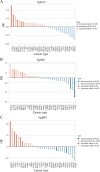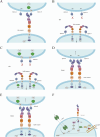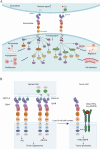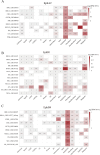Ephs in cancer progression: complexity and context-dependent nature in signaling, angiogenesis and immunity
- PMID: 38811954
- PMCID: PMC11137953
- DOI: 10.1186/s12964-024-01580-3
Ephs in cancer progression: complexity and context-dependent nature in signaling, angiogenesis and immunity
Abstract
Eph receptors constitute the largest family of receptor tyrosine kinases, comprising 14 distinct members classified into two subgroups: EphAs and EphBs.. Despite their essential functions in normal physiological processes, accumulating evidence suggests that the involvement of the Eph family in cancer is characterized by a dual and often contradictory nature. Research indicates that Eph/ephrin bidirectional signaling influences cell-cell communication, subsequently regulating cell migration, adhesion, differentiation and proliferation. The contradictory functionalities may arise from the diversity of Eph signaling pathways and the heterogeneity of different cancer microenvironment. In this review, we aim to discuss the dual role of the Eph receptors in tumor development, attempting to elucidate the paradoxical functionality through an exploration of Eph receptor signaling pathways, angiogenesis, immune responses, and more. Our objective is to provide a comprehensive understanding of the molecular mechanisms underlying tumor development. Additionally, we will explore the evolving landscape of utilizing Eph receptors as potential targets for tumor therapy and diagnostic tools.
Keywords: Eph/ephrin; Immune; Pain; Tumor; Vascular.
© 2024. The Author(s).
Conflict of interest statement
The authors declare no competing interests.
Figures






Similar articles
-
Eph/Ephrin Signaling in the Tumor Microenvironment.Adv Exp Med Biol. 2021;1270:45-56. doi: 10.1007/978-3-030-47189-7_3. Adv Exp Med Biol. 2021. PMID: 33123992
-
The Eph/Ephrin family in cancer metastasis: communication at the service of invasion.Cancer Metastasis Rev. 2012 Jun;31(1-2):353-73. doi: 10.1007/s10555-012-9352-1. Cancer Metastasis Rev. 2012. PMID: 22549394 Review.
-
Role of Eph/ephrin tyrosine kinase in malignant glioma.Neuro Oncol. 2011 Nov;13(11):1163-70. doi: 10.1093/neuonc/nor102. Epub 2011 Aug 19. Neuro Oncol. 2011. PMID: 21856686 Free PMC article. Review.
-
Eph-dependent cell-cell adhesion and segregation in development and cancer.Cell Mol Life Sci. 2012 Jun;69(11):1813-42. doi: 10.1007/s00018-011-0900-6. Epub 2011 Dec 28. Cell Mol Life Sci. 2012. PMID: 22204021 Free PMC article. Review.
-
Role of the ephrin and Eph receptor tyrosine kinase families in angiogenesis and development of the cardiovascular system.J Pathol. 2006 Mar;208(4):453-61. doi: 10.1002/path.1937. J Pathol. 2006. PMID: 16470907 Review.
References
-
- Brantley-Sieders DM, Zhuang G, Hicks D, Fang WB, Hwang Y, Cates JM, Coffman K, Jackson D, Bruckheimer E, Muraoka-Cook RS, Chen J. The receptor tyrosine kinase EphA2 promotes mammary adenocarcinoma tumorigenesis and metastatic progression in mice by amplifying ErbB2 signaling. J Clin Invest. 2008;118:64–78. doi: 10.1172/JCI33154. - DOI - PMC - PubMed
Publication types
MeSH terms
Substances
Grants and funding
- 2023ZZTS0864/the Fundamental Research Funds for the Central Universities of Central South University
- 81972198/National Natural Science Foundation of China
- 81773147/National Natural Science Foundation of China
- kq2208299/Natural Science Foundation, Changsha
- ZLXD2017004/Strategic Priority Research Program of Central South University
LinkOut - more resources
Full Text Sources
Miscellaneous

